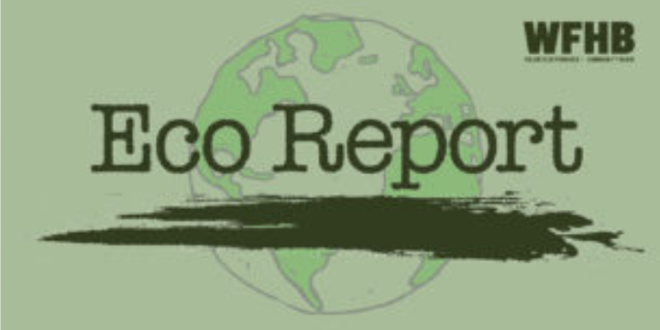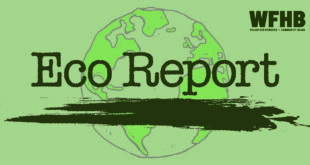Podcast: Play in new window | Download (Duration: 29:56 — 41.2MB)
Subscribe: RSS
| Hello and welcome to EcoReport. For WFHB, I’m Julianna Dailey. And I’m Frank Marshalek. In this edition of EcoReport, we have the second half of a discussion between Environmental Correspondent Zyro Roze and Delaney Barber – Outreach, Energy and Climate Coordinator for the Hoosier Environmental Council. |
|
And now for your environmental reports: WTHR of Indianapolis reports Indiana sees nearly double the number of air quality alerts in 2023 than 2022. New numbers released by the Indiana Department of Environmental Management show it’s a more volatile summer than normal for Hoosiers. Feeling like you’ve suffered a smokier summer than last year? It’s not just your imagination. The state’s leading environmental organization has recorded nearly double the amount of air quality alerts in 2023 than 2022. Officials with the Indiana Department of Environmental Management revealed while they issued a total of 13 Air Quality Action Days in 2022, we have already seen nearly double that number well before summer’s end. So far in 2023, 25 Air Quality Action Days have been issued. Of those 25 total alerts, 14 were issued because of ozone pollution, and 10 were issued because of particle pollution from fine particles, or PM 2.5 pollution. Air quality alerts issued by IDEM can be triggered by both particle and ground level ozone pollution, although 2023 did record one air quality alert so far that resulted from both types of pollution. Particle pollution has a single pollution source, like soot from fires, dust, factory debris or fossil fuel emissions, which are all examples of particulate matter. In the most recent case, the Canadian wildfires would be the single pollution source that’s sending an excess of fine particulate matter into the air. Exposure to PM 2.5 has been linked to premature death in people with heart or lung disease, nonfatal heart attacks, and irregular heartbeats. One study from Harvard found more exposure to PM 2.5 is linked to higher rates of death from COVID-19. The Indiana Legislature is not particularly concerned with air quality as demonstrated by their total support of the coal industry and their efforts to marginalize wind and solar. —Norm Holy |
| According to PBS, of all extreme weather conditions, heat is the deadliest. It kills more people in the U.S. in an average year than hurricanes, tornadoes and floods combined. The human body has a built-in cooling mechanism – sweat. But that system can only do so much, especially in soaring temperatures with high humidity. When your body is exposed to heat, it will try to cool itself down by redirecting more blood to the skin, says Ollie Jay, a professor of heat and health at the University of Sydney, where he directs the Heat and Health Research Incubator. But that means less blood and less oxygen are going to your gut. If these conditions go on long enough, your gut can become more permeable.
So, nasty things like endotoxins that usually reside and stay inside the gut start leaking out of the gut, entering the circulation. And that sets off a cascade of effects that ultimately result in death, Jay says. The second way people die in high heat also has to do with your body pumping more blood to the skin. Your heart has to pump faster – which can make you feel lightheaded – to keep your blood pressure up. We might have a heart rate of 60 beats per minute, all of a sudden, we might be asking the heart to contract 100 times per minute, 110 times per minute. So now you’re asking the heart to do a lot more work, Jay says. Those spikes in the heart rate can be triggers for a heart attack, he says, especially for the elderly and those with underlying heart conditions. The third deadly danger has to do with the fluids your body is losing in extreme heat. People can sweat as much as a liter and half per hour, Jay says. And if you don’t replenish those fluids, you get dehydrated and your blood volume shrinks, which makes it harder to maintain blood pressure. That can strain your heart and your kidneys. —Norm Holy |
| The ‘Era of Global Boiling’ has arrived, according to the UN Chief. As heat waves and wildfires cause chaos in North Africa, Europe and North America, climate scientists from the United Nations have announced that it is almost certain this July will be the warmest month ever recorded. However, world-wide record-keeping only began in 1880. There are millions of years where the earth was warmer because of volcanic activity.
At a press conference Thursday on climate, UN Secretary General António Guterres warned, “The era of global warming has ended; the era of global boiling has arrived,” a UN press release said. Today, the World Meteorological Organization and the European Commission’s Copernicus Climate Change Service are releasing official data that confirms that July 2023 is set to be the hottest month ever recorded in human history, Guterres said. The consequences are clear, and they are tragic: children swept away by monsoon rains; families running from the flames; workers collapsing in scorching heat. Chris Hewitt, the World Meteorological Organization’s director of climate services, said that, based on 173 years of data, the eight warmest years on record occurred from 2015 to 2022, and that substantial warming had been happening since the 1970s, UN News reported. Climate change is here… And it is just the beginning, Guterres said, as reported by UN News. Guterres emphasized that global action was needed now on the emissions and climate adaptation and finance fronts. No more hesitancy. No more excuses. No more waiting for others to move first, Guterres said in the press release. We have seen some progress. A robust rollout of renewables. Some positive steps from sectors such as shipping. But none of this is going far enough or fast enough. Accelerating temperatures demand accelerated action. In spite of the enormous evidence of climate change, the Indiana Legislature responds as if the year is 1955. Exploit all natural resources, and allow high levels of pollution – that’s the mantra of our leaders. —Norm Holy |
| You know it’s hot when cactuses are dying. CNN reports that at a botanical garden in Phoenix some cactuses can’t take the heat. Record-high temperatures in Arizona, combined with a lack of seasonal monsoons, have caused saguaro cactuses at the Desert Botanical Garden to become “highly stressed,” according to Chief Science Officer Kimberlie McCue. She said a saguaro can appear “fairly normal” or feel somewhat squishy before it suddenly collapses and reveals it has been rotting from the inside out due to heat-related stress.
Every February, the Desert Botanical Garden takes inventory of its saguaro cactuses and assesses each one’s condition. McCue said since 2020, when record temperatures caused stress in many of the saguaros, she and her team have seen more of the garden’s cactuses die. Present-day heat records are sending some of those previously affected cactuses over the edge, causing them to lose limbs and even collapse. —Norm Holy |
| Given water temperatures in the mid-90s around south Florida, the coral reefs are in danger. CBS News published an update on July 24.
Coral reefs play a vital role in the overall health of the planet. And off the coast of Florida, they’re in jeopardy, as the relentless heat continues. The Coral Restoration Foundation said in one coral reef restoration site off the state’s coast, the extreme temperatures have proved deadly. (quote) On July 20th, foundation teams visited Sombrero Reef, a restoration site we’ve been working at for over a decade. What we found was unimaginable — 100% coral mortality,(end quote) said Phanor Montoya-Mayoa, a restoration program manager at the foundation who has a doctorate in biology. We have also lost almost all the corals in the Looe Key Nursery in the Lower Keys. Sombrero Reef is a protected area off the Florida Keys, just past Marathon. It’s a popular site for snorkelers and divers as the area is home to star corals that are considered endangered under the Endangered Species Act. The Coral Restoration Foundation has been on a mission to restore the reef, spending years planting and protecting various corals. All of the efforts to reduce global warning have proven inadequate to slow the pace of warming. The growth in atmospheric carbon dioxide increases every year. Therefore, it is likely the coral reefs around Florida will be dead for several centuries. One approach to establish reefs would be to introduce corals farther north, perhaps along the Outer Banks, and/or Long Island. —Norm Holy |
| And now, we go to Environmental Correspondent Zyro Roze as he explores funding provisions of the federal Inflation Reduction Act and other climate pollution reduction measures being advocated and implemented in Indiana with Delaney Barber of the Hoosier Environmental Council. To learn more about the Hoosier Environmental Council and Hoosiers for Community Solar, see the HEC website at www.hecweb.org.
|
| For EcoReport, I am Julianna Dailey. And, I am Frank Marshalek. Are you looking for a way to make a difference on environmental issues? Here at EcoReport we are currently looking for reporters, engineers, and segment producers. Our goal is to report facts on how we’re all affected by global climate disruption and the ongoing assaults on our air, land and water.
We also celebrate ecologists, tree huggers, soil builders and an assortment of champions who actively protect and restore our natural world, particularly those who are active in south central Indiana. All levels of experience and all ages are welcome, and we provide the training you’ll need. W-F-H-B also offers internships. To volunteer for EcoReport, give us a call at (812) 323-1200, or e-mail us at: [email protected]. |
|
And now for some upcoming events: Participate in a Wildflower Identification Workshop at the Goose Pond Fish and Wildlife Area on Saturday, August 5th, from 9 am to Noon. You will learn how to identify native prairie plants and how they benefit pollinators. Snacks and beverages will be provided. You must register for this event to Ethan Plumier at [email protected] or call 812-512-9159. |
| Do you have a Hive Mind? Join the park naturalist at Brown County State Park on Sunday, August 6th, from 11 to 11:30 am for an informative presentation about honey bees. You will learn from the honey bee hive at the park’s Nature Center and understand how these insects create an elaborate society and serve as pollinators. |
| Learn about Animal Tracks at Spring Mill State Park on Monday, August 7th, from 2 to 2:30 pm. Find out who has been in your yard. Meet the Naturalist on the patio at the Lakeview Nature Center for a short walk to see who has visited the lake. |
| A Seeing Stars program will take place at the Paynetown State Recreation Area at Monroe Lake on Saturday, August 12th, from 7 to 8:30 pm. Discover how to identify some of the constellations and hopefully, get to view the Perseid Meteor Shower. |
| Enjoy a Frog Talk and Hike at Spring Mill State Park on Sunday, August 13th, from 11 to 11:30 am. Meet the Naturalist Jill on the back patio of the Nature Center to learn about amphibians and their calls. |
| And that wraps up our show for this week. EcoReport is brought to you in part by M-P-I Solar, a Bloomington business specializing in solar hot water, solar electricity and solar hot air systems. M-P-I Solar designs and installs solar power generation systems that encourage independence and individual responsibility. Found locally at 812-334-4003 and on the Web at mpisolarenergy.com. |
| This week’s headlines were written by Norm Holy. Today’s news feature was produced by Zyro Roze and edited by Noelle Herhusky-Schneider. Julianna Dailey assembled the script which was edited by Zyro Roze. Julianna Dailey compiled our events calendar. Kade Young and Noelle Herhusky-Schneider produced today’s show. Branden Blewett is our engineer. For WFHB, I’m Julianna Dailey. And I am Frank Marshalek. And this is EcoReport. |
 WFHB Bloomington Community Radio
WFHB Bloomington Community Radio




